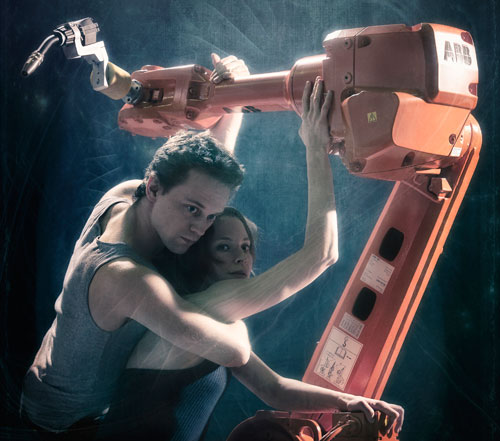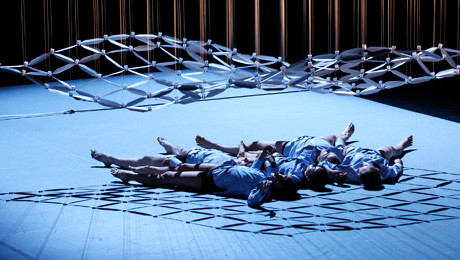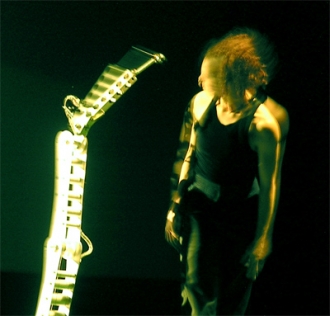
Robohub.org
Dancing with robots
Robots parodying the latest video hits are cute but some choreographers, artists and human-robot interaction specialists have pushed the boundary of how humans and robots move in fascinating ways. Thomas Freundlich has just uploaded a video of his work “Human Interface” with ABB industrial robots, which spurred me to post a snapshot or two from the history of robot choreography.

“Human Interface” is an evening length piece for 4 dancers, 2 human and 2 robots and is an extension of Freundlich’s 2008 work “Actuator”. Freundlich programs the industrial arms himself, using the ABB Robot Studio software and the Safe Mode capabilities, allowing humans to cowork with robots. Freundlich is himself one of the dancers and finds that robots can make very nuanced dancers with the ability to consistently repeat very finely tuned movements. “Human Interface” premiered at the Zodiak Center in Helsinki in 2012 to rave reviews.
“If someone still thinks contemporary dance is a joke, they would do well to make their way to the Pannuhalli stage of the Cable Factory and reconsider their opinion. There, a spectacle awaits: Two real industrial robots and two dancers, along with a world-class stage designer and musician offer an experience reminiscent of James Cameron’s film Avatar (2009). For me, this dance work was more three-dimensional and scarier than the film.”
– Marja Hannula, Helsingin Sanomat, Finland’s leading daily newspaper, May 24th 2012
Both Staubli and Kuka have also produced dancing robots, with Staubli’s RoboLounge homage to Daft Punk and Kuka’s synchronized robot arms which are also used by robot cinematography company BotNDolly. But Freundlich’s work is more closely aligned with pioneering human/machine choreography by the likes of Margie Medlin, Gideon Obarzanek and Margo Apostolo.

Gideon Obarzanek, of Chunky Move, is renowned for utilizing digital technologies, lasers, motion capture and projection. In recent works, like Connected, Obarzanek inverts his technological aesthetic in partnership with sculptor Reuben Margolin, to create a work which animates both the body and the machine through physical connection between the dancers and Margolin’s purpose-built, kinetic sculpture.
Reuben’s startlingly live sculptural works – constructed from wood, re-cycled plastic, paper and steel – transcend their concrete forms once set into motion, appearing as natural waveforms in a weightless kinetic flow. Suspended by hundreds of fine strings receiving information from multiple camshafts and wheels, his sculptures reveal in articulate detail the impulses of what they are coupled to. In Connected, it is people – athletic and agile dancers’ bodies twisting and hurtling through space, as well as people in recognisable situations.
Beginning with simple movements and hundreds of tiny pieces, the dancers build their performance while they construct the sculpture in real time. During the performance, these basic elements and simple physical connections quickly evolve into complex structures
and relationships.
All gods are homemade, and it is we who pull their strings, and so, give them the power to pull ours. (Aldous Huxley).
” Obarzanek seems to function in many ways as an irritant, disrupting our comfortable experiences of dance, confounding notions of illusion and representation, and disturbing the criteria by which dance might be judged good or bad.” [THE AGE]

However, Obarzanek rides on the shoulders of pioneering moving image, moving body choreographers like Margie Medlin. With a background in film and dance, Medlin has crossing the boundaries of art and science for well over 25 years. Her recent installations devise software and hardware tools that create a highly intelligent reflection on dance through the media of new technology.
Medlin’s Quartet Project, from 2004 to 2007, was a dance, music, new-media and robotic performance that observes and articulates communication and perception of the human body. It will explore and create real-time relationships between music, the gesture of playing music, dance, robotics and animation. Quartet was a collaboration between artists, technicians and scientists; with Stevie Wishart: musical director; Rebecca Hilton: choreographer; Holger Deuter (DNA 3d): animation / interactive / motion capture / real – time set; Gerald Thompson: motion control camera robot; Nick Rothwell: interface designer. The biomedical science of hearing implemented in Quartet was produced in association with The Physiology Lab, University of Cambridge.
The Quartet project commissioned complex tools to create visual bridges between cyberspace, augmented reality and physical space. These systems present a versatile and creative process for experimenting with cause and effect in multiple media; an insight into what it means to transform one medium or gesture into a completely different one. Technically theses tools create a motion capture system, combining two skeletons, one from the data of a dancer and one from the data of a musician. Together they explore the choreography of cinematic space and the poetics of looking and moving.
Quartet was a project to develop a real-time interactive robot to perform live in stage with a dancer and a musician. Advanced motion control technology was used to capture the dancer’s movements. I chose motion sensors made by Microstrain in the US. These were interfaced via a serial data protocol radio link devised by Glen Anderson and converted to motor control signals at the robot. Movement data could also be simultaneously recorded by a separate computer running Motion Builder software, as well as control a 3D Avatar which was projected onto a screen behind the performer.[Gerald Thompson]
Robot choreography can be traced back through the work of Margo Apostolos, both live and in publication, from “A comparison of the artistic aspects of various industrial robots” [1988] and “Robot Choreography” [1990], to her more recent work with Mark Morris. Dr. Apostolos was instrumental in bringing internationally-renown director/choreographer Mark Morris to USC for a workshop that integrated motion-capture and robotics with modern dance. Robot Choreography was developed as an artistic scientific collaboration to explore an aesthetic dimension of robotic movement. Robots and control techniques developed based on biological principles can assist in the transference of techniques developed for human choreography to programming aesthetic robot motion. The resultant form of choreographed robot movement integrated art and technology as a possible new art form with relevant research implications.
Dr. Apostolos is Director of Dance and Associate Professor in the USC School of Dramatic Arts. She has authored and presented numerous articles on her research and design in Robot Choreography. In addition to her doctoral and post-doctoral studies at Stanford University, she earned an M.A. in Dance from Northwestern University. She has served as visiting professor in the Department of Psychology at Princeton University and has taught in Chicago, San Francisco, at Stanford University, Southern Illinois University and California Polytechnic State University-San Luis Obispo. A recipient of the prestigious NASA/ASEE Summer Faculty Fellowship, Dr. Apostolos worked for NASA at Jet Propulsion Laboratory/Caltech as a research scientist in the area of space telerobotics.
“The Robot Etudes”, was published in 2010 by students in the department of Immersive Kinematics at the University of Pennsylvania, outlining Apostolos contribution to robot choreography, the history of robotics and theater and some of the research and pragmatic implications for ongoing work in human-machine interaction.
In spring of 2010, architecture and engineering students at the University of Pennsylvania were teamed together to create artistic mechatronic robotic devices. The context for their creations was Shakespeare’s A Midsummer Night’s Dream. This became a joint effort between professors from Mechanical Engineering and Architecture and a director from a professional theater troupe instructing a group of students to develop a performance performed by the Pig Iron Theatre Troupe at the Annenberg Center called The Robot Etudes. Whereas robots have been used in theater before and artistic directors have instructed technicians to develop special effects robots, developing robotic elements specifically for theater with a diverse set of creative innovators is new. This paper focuses on the process by which the play was formed and the successes and struggles in forming a cooperative experiment between three very different disciplines.
Immersive Kinematics is a collaboration between Penn Engineering and Penn Design and expands the roles of architecture and engineering focusing on integrating robotics, interaction, and embedded intelligence in our buildings, cities, and cultures. The group offers a class teaming architecture and engineering students in mechatronic projects.
This article on “Dancing with Robots” can only offer a small taste of some of the amazing works of collaboration, between humans and robots and between artists, engineers and scientists. A while ago, I also reviewed the SEAM 2010 exhibition in Sydney which showcased many other works of interactive machine human aesthetic, both digital, virtual and mechanical. From Stelarc, Obarzanek and Medlin, to Paul Granjon, Petra Gemeinbock, Frederic Bevilacqua, Chris Ziegler and many more.
The human-robot interaction history is much richer and more nuanced than the current crop of cute robot dance videos would suggest. Although, if Aldebaran’s plans for a robot dance competition take off, then perhaps they will be inspiring a new generation of collaborative human-robot artists.
tags: ABB, choreography, Gideon Obarzanek, human-robot interaction, Immersive Kinematics, Kuka, Margie Medlin, Margo Apostolos, Staubli, Thomas Freundlich




